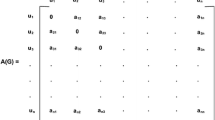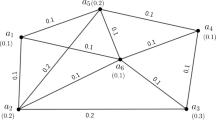Abstract
Connectivity and strength has a major role in the field of network connecting with real world life. Complexity function is one of these parameter which has manifold number of applications in molecular chemistry and the theory of network. Firstly, this paper introduces the thought of complexity function of fuzzy graph with its properties. Second, based on the highest and lowest load on a network system, the boundaries of complexity function of different types of fuzzy graphs are established. Third, the behavior of complexity function in fuzzy cycle, fuzzy tree and complete fuzzy graph are discussed with their properties. Fourth, applications of these thoughts are bestowed to identify the most effected COVID-19 cycles between some communicated countries using the concept of complexity function of fuzzy graph. Also the selection of the busiest network stations and connected internet paths can be done using the same concept in a graphical wireless network system.












Similar content being viewed by others
Explore related subjects
Discover the latest articles, news and stories from top researchers in related subjects.Change history
22 June 2023
A Correction to this paper has been published: https://doi.org/10.1007/s10462-023-10495-3
References
Bertz SH (1987) A mathematical model of molecular complexity. In: King RB (ed) Chemical applications of topology and graph theory. Elsevier, Amsterdam, pp 206–221
Bhutani KR, Rosenfeld A (2003) Fuzzy end node in fuzzy graphs. Inf Sci 152:323–326
Bhutani KR, Rosenfeld A (2003) Strong arc in fuzzy graphs. Inf Sci 152:319–322
Binu M, Mathew S, Mordeson JN (2019) Connectivity index of a fuzzy graph and its application to human trafficking. Fuzzy Sets Syst 360:117–136
Binu M, Mathew S, Mordeson JN (2020) Wiener index of a fuzzy graph and application to illegal immigration networks. Fuzzy Sets Syst 384:132–147
Borzooei RA, Rashmanlou H (2016) Degree and total degree of edges in bipolar fuzzy graphs with application. J Intell Fuzzy Syst 30(6):3271–3280
Cary M (2018) Perfectly regular and perfectly edge-regular fuzzy graphs. Ann Pure Appl Math 16(2):461–469
Dehmer M, Chen Z, Streib FE, Tripathi S, Mowshowitz A, Levitchi A, Feng L, Shi Y, Tao J (2019) Measuring the complexity of directed graphs: a polynomial based approach. PLOS One 14(11):e0223745. https://doi.org/10.1371/journal.pone.0223745
Dudek WA, Talebi AA (2016) Operation on level graph of bipolar fuzzy graphs. Buletin Academiel de Stiinte A Republic Moldova Matemtica 2(8):107–124
Gani AN, Ahamed MB (2003) Order and size in fuzzy graph. Bull Pure Appl Sci 22E(1):145–148
Ghorai G, Jacob K (2019) Recent developments on the basics of fuzzy graph theory. In: Pal M, Samanta S, Pal A (eds) Handbook of research on advanced applications of graph theory in modern society. IGI Global, United States
Ghorai G, Pal M (2016) Some isomorphic properties of \(m\)-polar fuzzy graphs with applications. SpringerPlus 5(1):2104
Harris J, Hirst JL, Mosinghoff M (2008) Combinatorics and graph theory. Springer, New York
Lakdashti A, Rashmanlou H, Borzooei RA, Samanta S, Pal M (2019) New concepts of bipolar fuzzy graphs. J Multiple-Valued Logic Soft Comput 33(1–2):117–133
Mahapatra R, Samanta S, Pal M, Lee J, Khan SK, Naseem U, Bhadoria RS (2021) Colouring of COVID-19 affected region based on fuzzy directed graphs. Comput Mater Continua 68(1):1219–1233
Mariappan S, Ramalingam S, Raman S, Turan GB (2019) Domination integrity and efficient fuzzy graphs. Neural Comput Appl 32:10263–10273
Mathew S, Sunitha MS (2009) Types of arcs in a fuzzy graph. Inf Sci 179(11):1760–1768
Mathew S, Mordeson JN, Malik D (2018) Fuzzy graph theory. Springer, Berlin
Mathew S, Yang HL, Mathew JK (2018) Saturation in fuzzy graphs. New Math Nat Comput 14(1):113–128
Minoli D (1975) Combinatorial graph complexity, Atti della Accademia Nazionale dei Lincei. Class di Scienze Fisiche, Matematiche e Naturali. Rendiconti, 59(6), 651-661
Mordeson JN, Nair PS (2000) Fuzzy graphs and fuzzy hypergraphs. Physica-Verlag, Germany
Mordeson JN, Peng CS (1994) Operation on fuzzy graphs. Inf Sci 79:159–170
Mordeson JN, Mathew S, Malik D (2018) Fuzzy graph theory with applications to human trafficking. Springer, Berlin
Mordeson JN, Mathew S, Malik DS (2018) Generalized fuzzy relations. New Math Nat Comput 14(2):187–202
Mowshowitz A (1968) Entropy and the complexity of graphs: I. an index of the relative complexity of a graph. Bull Math Biophys 30:175–204
Nagoorgani A, Hussain RJ (2008) Connected and global domination of fuzzy graph. Bull Pure Appl Sci 27E(2):1–11
Poulik S, Ghorai G (2020) Detour g-interior nodes and detour g-boundary nodes in bipolar fuzzy graph with applications. Hacettepe J Math Stat 49(1):106–119
Poulik S, Ghorai G (2020) Note on bipolar fuzzy graphs with applications. Knowl Based Syst 192:1–5
Poulik S, Ghorai G (2021) Determination of journeys order based on graph’s Wiener absolute index with bipolar fuzzy information. Inf Sci 545:608–619
Poulik S, Ghorai G (2020) Certain indices of graphs under bipolar fuzzy environment with applications. Soft Comput 24(7):5119–5131
Poulik S, Ghorai G, Xin Q (2020) Pragmatic results in Taiwan education system based IVFG & IVNG. Soft Comput. https://doi.org/10.1007/s00500-020-05180-4
Rashmanlou H, Samanta S, Pal M, Borzooei RA (2015) Bipolar fuzzy graphs with categorical properties. Int J Comput Intell Syst 8(5):808–818
Rashmanlou H, Samanta S, Pal M, Borzooei RA (2016) Product of Bipolar fuzzy graphs and their degrees. Int J Gen Syst 45(1):1–14
Rosenfield R (1975) Fuzzy graphs. In: Zadeh LA, Fu KS, Shimura M (eds) Fuzzy sets and their application. Academic press, New York, pp 77–95
Sunitha MS, Vijayakumar A (1999) A characterization of fuzzy trees. Inf Sci 113(3–4):293–300
Talebi AA (2018) Cayley fuzzy graphs on the fuzzy groups. Comput Appl Math 37:4611–4632
Talebi AA, Ghassemi M, Rashmanlou H (2020) New concepts of irregular-intuitionistic fuzzy graphs with applications. Ann Univ Math Comput Sci Ser 47(2):226–243
Talebi AA, Ghassemi M, Rashmanlou H, Broum S (2021) Novel properties of edge irregular single valued neutrosophic graphs. Neutrosophic Sets Syst 43:255–279
Thirunavukarasu P, Suresh R, Viswanathan KK (2016) Energy of a complex fuzzy graph. Int J Math Sci Eng Appl 10(1):243–248
Todeschini R, Consonni V (2000) Handbook of molecular descriptors. Wiley, London
Trucco E (1956) A note on the information content of graphs. Bull Math Biophys 18:129–135
Yeh RT, Bang SY (1975) Fuzzy relations, fuzzy graphs and their applications to clustering analysis. In: Zadeh LA, Fu KS, Shimura M (eds) Fuzzy sets and their applications. Academic Press, London, pp 125–149
Zadeh LA (1965) Fuzzy sets. Inf Control 8:338–353
Acknowledgements
The authors would like to express their sincere gratitude to the anonymous referees for valuable suggestions, which led to great deal of improvement of the original manuscript. The first author is thankful to the Department of Higher Education, Science and Technology and Biotechnology, Government of West Bengal, India, for the award of Swami Vivekananda merit-cum-means scholarship (Award No. 52-Edn (B)/5B-15/2017 dated 07/06/2017) to meet up the financial expenditure to carry out the research work. The third author acknowledges the support of DST-FIST, New Delhi (India) (Sanction No. SR/FST/MS- I/2018/21) for carrying out this work.
Author information
Authors and Affiliations
Corresponding author
Ethics declarations
Conflict of interest
The authors declare that they have no conflict of interest.
Ethical approval
This article does not contain any studies with human participants or animals performed by any of the authors.
Additional information
Publisher's Note
Springer Nature remains neutral with regard to jurisdictional claims in published maps and institutional affiliations.
Rights and permissions
Springer Nature or its licensor (e.g. a society or other partner) holds exclusive rights to this article under a publishing agreement with the author(s) or other rightsholder(s); author self-archiving of the accepted manuscript version of this article is solely governed by the terms of such publishing agreement and applicable law.
About this article
Cite this article
Poulik, S., Ghorai, G. Estimation of most effected cycles and busiest network route based on complexity function of graph in fuzzy environment. Artif Intell Rev 55, 4557–4574 (2022). https://doi.org/10.1007/s10462-021-10111-2
Published:
Issue Date:
DOI: https://doi.org/10.1007/s10462-021-10111-2




